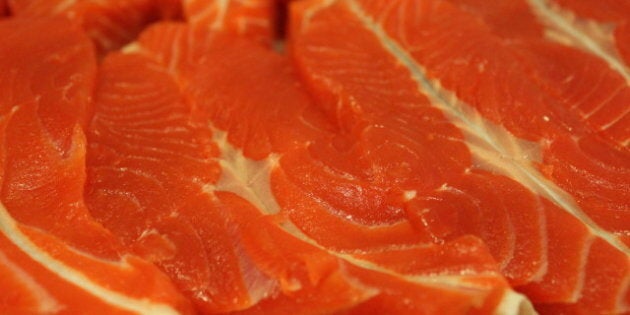
Farming Atlantic salmon in high tech closed containment land based operations, rather than in nets that sit in the ocean, is catching on. Today, viable technologies produce healthy farmed fish completely separate from the surrounding environment and wild fish. Around the world, farmers are recognizing that there is a lucrative market in supplying chefs and consumers who increasingly demand fish grown in an environmentally-sustainable manner.
A partnership between The Conservation Fund Freshwater Institute of West Virginia and the Atlantic Salmon Federation, a conservation organization with headquarters in St. Andrews NB, is producing healthy, unstressed farmed salmon, free of disease and sea lice, without vaccines, harsh chemicals, and antibiotics in closed-containment freshwater facilities on land. The goal is to give fish farmers and regulators the opportunity to choose a different way to grow fish that is, not only better for the environment but better for business, too.
The open net pen salmon farming industry greatly underplays the environmental impacts of farming salmon in open net pens in the ocean. Just one example is this industry's portrayal of outbreaks of Infectious Salmon Anemia (ISA) as a disease occurring naturally and to be expected as part of the business of farming salmon. In fact, this deadly flu-like disease is spread quickly among farmed salmon that are stressed in densely-packed open ocean net cages, wherever these farms exist -- Norway, Scotland, the Faroes, Chile, Maine, New Brunswick, Nova Scotia and now Newfoundland and Labrador.
In the Atlantic Canadian aquaculture industry, millions of farmed salmon have had to be slaughtered and the industry compensated with millions of taxpayers' dollars from provincial and federal governments. Would it not be more "economical" to circumvent the expense of destruction and compensation by growing salmon in disease-free closed containment facilities?
On the other hand, the industry greatly exaggerates the amount of land, water, and energy required in land-based freshwater closed containment facilities. The industry claims that 8,000 football fields would be required to put the salmon farming operations of NB and NS on land. In 2010, Canada produced 39,000 tonnes of farmed salmon on the Atlantic coast. The Conservation Fund Freshwater Institute in its research over two decades has found that growing 30,000 tonnes of salmon per year would require only 75 to 150 football fields (including the end zones), and growing 100,000 tonnes per year would require well under 500 football fields.
Then there are the myths most recently perpetuated by the industry that closed containment requires "too much energy" and "too much water." In actual fact, the technology used to farm fish in closed containment can be adapted for freshwater, brackish water, and seawater. Most of the water is cleaned and re-used; any that is not re-used is treated before being returned to the environment.
We have also come a long way in designing energy efficient closed-containment farms with electricity use for a 3,000 tonne farm in the range of 2,250kW. European companies investing in this technology indicate that they are now achieving electrical load that is 70 per cent less than this estimate. When considering carbon footprint, it is also important to take into account the local effects of untreated pollution being discharged from open net pen farms directly into the ocean. Ocean-based net pens do not have discharge limits, effectively placing the burden on the marine environment and other resource users, rather than where it belongs -- with the farmer.
Sure, transitioning to closed containment might mean that the aquaculture industry will not get its more than 50 per cent profit, but then taxpayers will not have to foot bills for disease compensation and lose the economic and social benefits from industries such as tourism, lobster fishing and the recreational fishery that rely on a healthy environment.